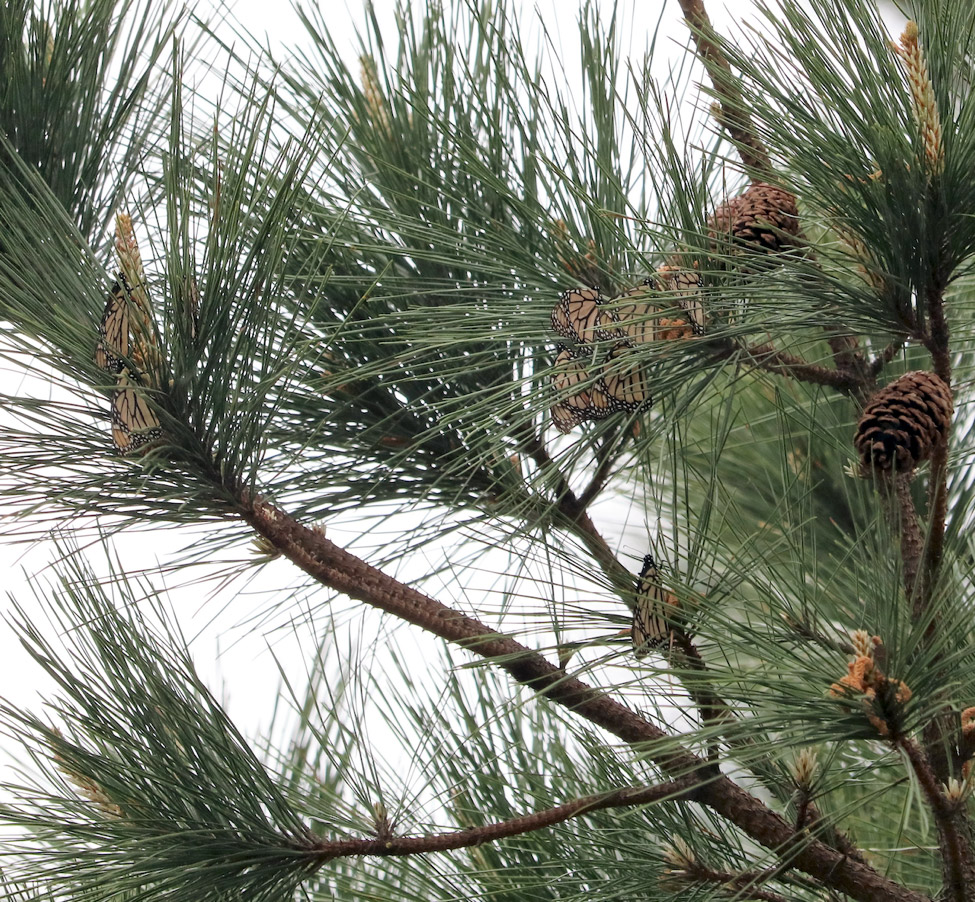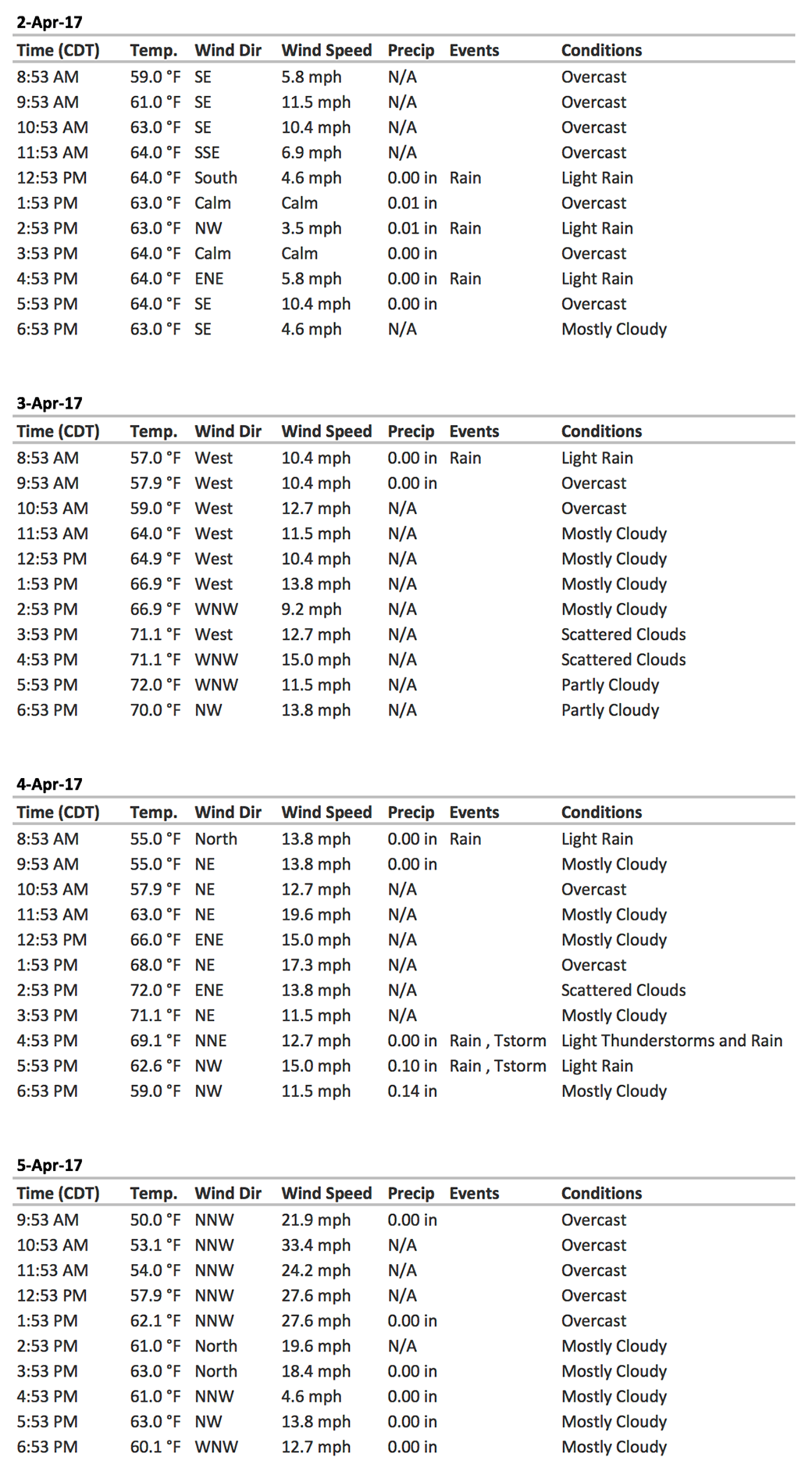Spring roosting: A rare event
Tuesday, April 11th, 2017 at 1:47 pm by Chip TaylorFiled under Monarch Migration | Comments Off on Spring roosting: A rare event
At 6:32PM on Tuesday (4 April) I received the following message from a landowner I know near Bixby, in northeastern Oklahoma.
“Looking at hundreds of monarchs right now on the pine trees down by our gate. I assume they blew in with the storms. It’s amazing!!”
My response was “Are you just trying to get me to call you? Or, are you seeing something that should be documented six ways from Sunday? If real, that is a first. REALLY!!!!”
You could tell I was excited.
I then went on to say that, if there were indeed hundreds of monarchs on the property at this time of year, it was remarkable, even extraordinary and a sight that may never have been reported.
I subsequently contacted Elizabeth Howard. Elizabeth, as most of you know, manages Journey North which has been recording first sightings of monarchs returning from Mexico since 1997. My question to Elizabeth was “In all the records of first sightings over the last decade and more, have you ever received a report of spring clustering that involves hundreds, perhaps thousands of monarchs?” Elizabeth answered “No we haven’t had clustering reports before other than this one of 50 in Tamaulipas:
learner.org/jnorth/sightings/query_result.html?record_id=1487466914”
I was pretty sure Elizabeth’s answer would be no, at least not in the United States. So, over and over again, I pressed my colleague to get pictures, estimate numbers and to document the event as thoroughly as possible. Credibility is important. I’ve been there. I saw a mountain lion once just a mile from my house, but the ground was frozen and there were no tracks or other evidence. So, to this day, I only mention the event when I’m with those who believe in and want to hear mountain lion stories.
Back in Oklahoma it was a dark and windy night but monarchs kept coming into the pine trees and did so until last light. The winds were from the south and most of the clusters formed on the north side of the pine trees. The clusters were small and scattered. Some clusters formed in isolated pines but no clusters were found on the neighboring oaks or other tree species.
The next morning it was cool and overcast and the monarchs weren’t moving. My colleague tried to take pictures of the clustered monarchs. It was difficult since the clusters were high in the trees and the monarchs blended in with the pine cones and were nestled deeply within the pine needles. The best picture is below. If you look closely, you can see 8 monarchs.

Although most of the monarchs were in a row of pines, others were found in pine trees scattered over 2-3 acres. The first estimate on Wednesday morning suggested that there were roughly 500-1000 monarchs in the trees. Later, after a more thorough search over a slightly larger area, the estimate grew to 1200 to perhaps as many as 2000. (I should say at this point that the latter estimate was made by someone who routinely works with large numbers of butterflies).
The weather was pretty iffy at this location throughout the day on Wednesday. There were strong winds from the north and the temperature grudgingly inched up to 60F with a few intervals of sunshine. In spite of the winds and low temperatures, some monarchs were seen puddling and others seemed to be leaving the area. Yet, it looked as if some would remain for another night and that’s what happened. This morning (6 April) roughly 150 monarchs remained in the area.
This event raises lots of questions. Data from first sightings and first eggs as reported to Journey North would seem to suggest that monarchs fan out and become highly dispersed as they move into the United States from Mexico. There is no literature, and there are no observations, that I’m aware of that would suggest 2000 monarchs would converge on a small parcel of land as far north as northeastern Oklahoma to form overnight clusters.
This event followed a series of storms that moved into Oklahoma from Texas. Winds associated with these storms were variable with some from the WSW raising the possibility that the weather patterns and the habit of monarchs to ride tail or quartering winds caused them to converge and to seek refuge at a site that offered protection from the winds. We will try to dig into the weather data to see if we can learn more about the conditions preceding and during this event.
During fall migration, if you follow the flight of single monarchs that are looking for a roost site at the end of the day, one after another can be seen headed in the same direction, and along what appears to be the same path, usually toward the highest feature on the horizon. That behavior often takes them to trees at the tops of hills. The site of these observation was also on a hilltop. Fall or spring, clustering high in trees in refuge sites on hills has the effect of protecting monarchs from freezing temperatures. It’s possible that this phenomenon occurs from time to time but goes unobserved because few of us would think of looking for spring clusters on hilltops.
Two other points are worthy of mention. While many of the monarchs appeared to be in good condition, others were quite worn and tattered. There was no way to determine the sex ratio but the clusters were composed of both males and females.
As I was finishing this text, I received an email from my colleague written at 6:54 saying that 10 monarchs are in the process of forming a cluster on one of the pines. Spring monarchs in the trees three nights in a row. That’s amazing. It’s totally out of my experience.
ADDENDUM
The Weather and Assumptions
Before diving into the weather data, it’s useful to remind ourselves about the basic assumptions as to how monarchs interact with physical factors. Our assumptions are as follows:
1) Monarchs don’t fly at night
2) They are progressively dispersed in the spring as they move in a generally northeasterly direction in the United States
3) They advance using powered flight
4) When possible, they take advantage of tail and quartering winds to move NE.
5) They don’t advance into strong head winds unless there are areas where wind speed is low at ground level
6) They don’t fly in heavy rain
7) The minimum temperature for flight is close to 50F in full sunlight
8) The most rapid advances occur when temperatures exceed 65F with quartering winds from the SSW, SW and WSW.
There are observations and opinions but very little data that pertain to these assumptions, but let’s press on.
The data below are summaries of the times, temperatures, wind speed, wind direction, precipitation and cloud cover for the greater Tulsa, OK area (that includes Bixby) for 2-5 April 2017.
Daily summaries and interpretation
2 April. The temperatures ranged from 59-64F, winds were light and generally from the SE, overcast conditions prevailed with three periods of light rain. Monarch activity was probably light. Wind speed and direction probably had little impact on the amount and direction of flight. These were suboptimal conditions for advancing to the northeast and, it’s likely monarchs did not advance but remained where they were.
3 April. The temperatures ranged from 57-71F with temperatures from 66-71 through the afternoon. Winds were predominantly from the west but shifting a bit to the WNW toward the end of the day. Wind speed ranged from 9-15mph. While the day began as overcast there was a progression to mostly cloudy, partly cloudy and scattered clouds as the day progressed.
With these afternoon temperatures, wind speeds and directions, monarchs should have been on the move. Further, with quartering winds from the W and WNW, the net direction, or vanishing bearing, of monarchs in flight on the afternoon of the 3rd should have been to the ENE. In other words, monarchs from central OK would have been “pushed” towards the Tulsa area – IF, the underlying assumptions are true.
4 April. The temperatures ranged from 55-71F with temperatures ranging from 66-71F for the afternoon. Winds started from the N but shifted to the NE and ENE for most of the day but variable from the N and NW for the last hour of the day. Except for one brief period, winds ranged from about 11 to nearly 20mph. The skies were characterized as overcast, mostly cloudy, scattered clouds with periods of light rain and thunderstorms in the last hour and a half of the day. Under these conditions monarchs would have experienced quartering winds from the NE and ENE much of the day with the possible outcome of being “pushed” slightly to the NW. Just the opposite of what may have happened on the 3rd. In addition, with the advent of the thunderstorms and dropping temperatures after 5:30, directional flight should have declined and shifted to finding safer harbor for the night. This scenario is consistent with sightings of monarchs seeking shelter in pine trees after 6PM.
5 April. Temperatures ranged from 49 – 63F through the day. Winds were from the NW, N, NNW most of the day with wind speeds ranging from 18-32mph until 4PM but dropping somewhat in the last two hours of the day. Although some monarchs were observed puddling and leaving the pines at various times on the 5th, it is unlikely that those that left progressed very far given the head winds. It seems probable that most simply moved to other protected locations.
So, where does this leave us? How is it that 1200-2000 monarchs that probably overwintered came together in one small patch on a hilltop in northeastern Oklahoma? I won’t claim to know, but the data seem to be consistent with the hypothesis that prevailing winds caused monarchs moving through eastern Oklahoma to converge over a two-day period and to seek shelter in a place that offered some protection from unsettled conditions at the end of the second day.
Table 1. Hourly weather and observations for Tulsa, OK area (includes Bixby, OK) for 2-5 April 2017

For additional discussion on a similar spring migration observation, please see “A chance meeting and perhaps some insights on the spring migration” which is a reposting of a message sent via our Dplex-L email discussion list back on 1 May 2000.


Sorry, comments for this entry are closed at this time.